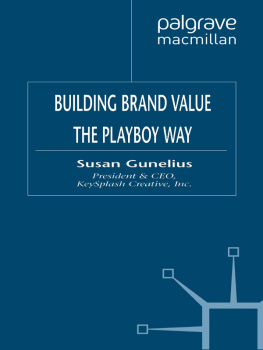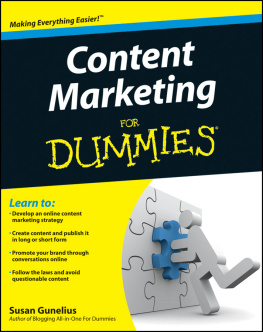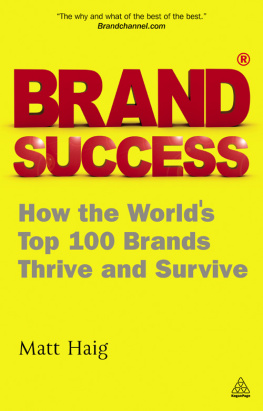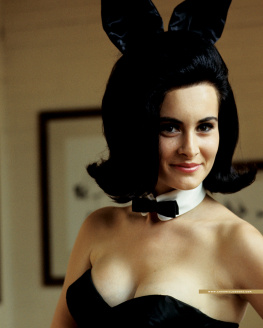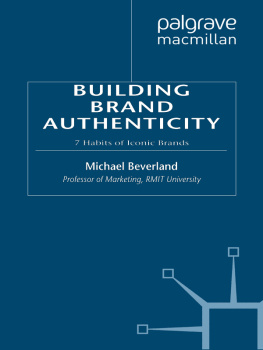BUILDING BRAND VALUE THE PLAYBOY WAY
Titles by the same author
Google Blogger for Dummies
Harry Potter: The Story of a Global Business Phenomenon
Kick-ass Copywriting in 10 Easy Steps
BUILDING BRAND VALUE THE PLAYBOY WAY
Susan Gunelius
President & CEO,
KeySplash Creative, Inc.


Susan Gunelius 2009
Foreword by Allen P. Adamson
All rights reserved. No reproduction, copy or transmission of this publication may be made without written permission.
No portion of this publication may be reproduced, copied or transmitted save with written permission or in accordance with the provisions of the Copyright, Designs and Patents Act 1988, or under the terms of any licence permitting limited copying issued by the Copyright Licensing Agency, Saffron House, 6-10 Kirby Street, London EC1N 8TS.
Any person who does any unauthorized act in relation to this publication may be liable to criminal prosecution and civil claims for damages.
The author has asserted her right to be identified as the author of this work in accordance with the Copyright, Designs and Patents Act 1988.
First published 2009 by
PALGRAVE MACMILLAN
Palgrave Macmillan in the UK is an imprint of Macmillan Publishers Limited,registered in England, company number 785998, of Houndmills, Basingstoke, Hampshire RG21 6XS.
Palgrave Macmillan in the US is a division of St Martins Press LLC, 175 Fifth Avenue, New York, NY 10010.
Palgrave Macmillan is the global academic imprint of the above companies and has companies and representatives throughout the world.
Palgrave and Macmillan are registered trademarks in the United States,the United Kingdom, Europe and other countries.
ISBN-13: 978-0-230-57789-3
This book is printed on paper suitable for recycling and made from fully managed and sustained forest sources. Logging, pulping and manufacturing processes are expected to conform to the environmental regulations of the country of origin.
A catalogue record for this book is available from the British Library.
A catalog record for this book is available from the Library of Congress.
10 9 8 7 6 5 4 3 2 1
18 17 16 15 14 13 12 11 10 09
Printed and bound in China
To Scott for watching The Girls Next Door with me and encouraging me to turn my thoughts into this book.
ILLUSTRATIONS
TABLES
I TimelineThe 1950s
II TimelineThe 1960s
III TimelineThe 1970s
IV TimelineThe 1980s
V TimelineThe 1990s
VI TimelineThe 2000s
FIGURES
4.1 Four orders of brand experience
7.1 The three stages of consumer emotional involvement
BOXES
1.1 The creation of the Playboy bunny logo
2.1 The Silent Generation
2.2 Understanding relationship branding
4.1 Defining an experience brand
4.2 Consumer emotional involvement theory
5.1 The Hard Rock Cafe and Jack Daniels as experience brands
5.2 Brand extension strategies and risks
6.1 The Baby Boomer Generation
6.2 I Was a Playboy Bunny by Gloria Steinem
6.3 How Toyota and Pepsi leveraged the macro environment with different results
7.1 Celebrities and writers in Playboy during the 1960s
7.2 The inclusive brand strategy of Barack Obamas 2008 U.S. Presidential Campaign
7.3 Cult brands
8.1 Generation Jones
9.1 Competitive market positioning strategies
9.2 Offensive and defensive positioning strategies
9.3 Brands that failed to meet customer expectations
9.4 Brand expansion without restraint
10.1 Awards and honors bestowed upon Hugh Hefner during the 1970s
11.1 Brands that faced decline and survived with mixed results
11.2 Brand survival stories
12.1 The repositioning of Clorox and Hyundai
13.1 Awards and honors bestowed upon Hugh Hefner during the 1980s
13.2 Success stories of extending and merchandising brands
13.3 The Hallmark Channel
14.1 Generation X
14.2 The power of celebrity brand endorsements
15.1 United States vs. Playboy Entertainment Group, Inc.
16.1 Awards and honors bestowed on Hugh Hefner in the 1990s
16.2 Integrated marketing in business
17.1 Generation Y
17.2 Interns
18.1 Steve Jobs: The Apple brand champion
18.2 Mary Kay Ash: The Mary Kay brand champion
18.3 Awards and honors bestowed on Hugh Hefner in the 2000s
19.1 Skoal and Playboy
FOREWORD
Ask any man who has read Playboy magazine at some point in his life and hell most likely tell you with a wink and a nod that its for the fiction. While the esteemed writers who contributed stories and essays to the publication include no less than the likes of Kurt Vonnegut, Norman Mailer, Saul Bellow, and John Steinbeck, the notion that anyone has ever read Playboy solely for the fiction is, well, a fiction. From its inception, men have enjoyed Playboy magazine because it represented one of the most well-defined and differentiated brand promises of the 20th century. It was an experience built upon a simple, yet meticulously planned and implemented brand idea: every mans dream of the good life. In its heyday, Playboy, the magazine and the empire, was a brand like no other. In fact, it may well have been in a brand class by itself.
That Playboy has achieved renown as a global brand is no accident. Its success is the result of founder Hugh Hefners adherence to the rules of Branding 101. With no formal background in brand management, Hefner still understood that strong brands are not built on logos, clever and ubiquitous as his turned out to be, but on a set of mental associations brought to life through a spectrum of carefully aligned experiences. From my own, more formal background in brand management, I can tell you that Susan Gunelius, engaging new book, The Playboy Brand, is not just a great tale skillfully told, but also a perfect lesson for anyone interested in what it takes to build a powerful brand, regardless of the category.
While he started the multimillion-dollar Playboy enterprise with $600 and a desire to challenge the repressive sexual attitudes of his day, Hefners ultimate achievement was his ability to identify a unique idea, a promise that was both different from any other in the category (no smut, please), and relevant to the target market. In addition, it was his ability to envision and put into play the array of experiences necessary to genuinely bring this idea to life. He understood that everything associated with the promise had to hold together from touch point to touch point, from one branding element to the next in order to be perceived as credible.
That this happened is legend. Hefs simple brand idea, actually articulated in a serialized manifesto entitled the Playboy Philosophy, was about as fine a strategic branding document as can be found in any top-notch marketing firm. Every mans dream of the urban, urbane lifestyle, the activities, manners and mors it embodied, were soundly articulated. Hefners belief that life should be a celebration, a cool embrace of sexy merry-making and marvelously uninhibited beautiful women (though innocent enough to take home to mom), of superior wining and dining, good grooming, good music and good times, was as watertight a rendition of brand guidelines as exists and men lived it and loved it. From branding applications that included clubs and restaurants, mansions, resorts and jets, and, yes, those endearing Bunnies (whom you actually

